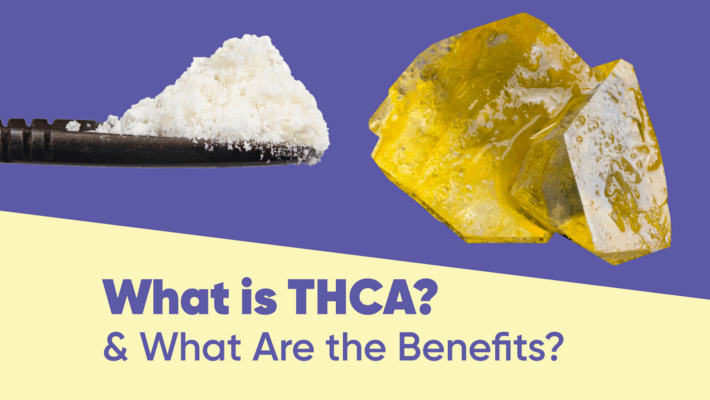
What is THCA & What Are the Benefits?
Published on 2/18/22
THC is one of the most important things to know about cannabis. It's a major cannabinoid that provides the psychoactive "high" effects associated with weed and has many medicinally beneficial properties. Almost everyone knows what THC is, even if they aren't part of the cannabis community. Did you know, though, that there are different types of THC and that THCA is the most abundant non-psychoactive cannabinoid in cannabis? Let's dive into this incredible compound and look at just how important it is.
The Compounds that Make of Cannabis
THC and CBD are the two most popular cannabinoids found in cannabis, and they are often synonymous with weed for many people. However, "THC" and "CBD" are not directly created in cannabis, a plant made up of over 400 different chemical compounds, of which more than 60 are cannabinoids. These cannabinoids include tetrahydrocannabinol (THC), cannabidiol (CBD), Cannabigerol (CBG), cannabichromene (CBC), and cannabinol (CBN). Cannabinoids are divided into different categories, which are phytocannabinoids, endogenous, purified, or synthetic cannabinoids.
 Unsplash
UnsplashThere are also cannabinoid acids, which are naturally occurring variations of cannabinoids that include tetrahydrocannabinolic acid (THCA), cannabidiolic acid (CBDA), cannabichromenenic acid (CBCA), cannabigerolic acid (CBGA), tetrahydrocanabivarinic acid (THCVA), and many more. These acids are the original forms that exist within cannabis before their cannabinoid counterparts like THC and CBD are pharmacologically active. Terpenes are another major compound found within cannabis, which are oils excreted from cannabis responsible for the plant's potent smell and flavor. Terpenes have several medical benefits, including anti-inflammatory, antioxidant, and antidepressant properties. Along with cannabinoids and terpenes, other compounds within cannabis include flavonoids and trichomes.
Independently, these compounds have different medicinal and recreational effects. Together, they combine to create what is known as the entourage effect, wherein all the compounds within cannabis interact to make the most heightened, wholistic effects. And when heated and consumed, some of these compounds, specifically the different cannabinoid acids, go through processes that result in a transformation, including non-psychoactive THCA into psychoactive Delta-9 THC.
What is THCA?

Short for tetrahydrocannabinolic acid, THCA is the most prolific non-psychoactive cannabinoid in cannabis. CBD is also non-psychoactive, but THCA is more prolific within cannabis (read more about CBD to understand the differences between THCA vs. CBD). While its name is very similar, THCA differs from THC in various ways. Most importantly, it has an extra carboxyl group that prevents our endocannabinoid system from absorbing it. It is a precursor to THC and can be turned into the popular psychoactive cannabinoid through the process of decarboxylation.
THCA Potency
On its own, THCA provides very little potency unless it is extracted into a concentrate such as powder or crystalline (which we will discuss later). This cannabinoid's extra carboxyl group (what makes THCA vs. THC different) can be removed through the process of decarboxylation, wherein heat is applied to THCA to alter the cannabinoid's structure. Once THCA goes through carboxylation, it turns into psychoactive THC that your body's endocannabinoid system can absorb. THCA is converted to THC when decarboxylated at roughly 87.7% efficacy, meaning that the final potency of a cannabis strain is the total percentage of THC plus the total percentage of THCA times .877. The formula for the total THC potency of cannabis is as follows: (THCA%) x 0.887 + (THC%).
THCA Benefits
However, THCA side effects include several medicinal benefits even when not converted into psychoactive THC. Research indicates that THCA has anti-inflammatory and neuroprotective properties, along with showing promise for slowing neurodegeneration and increasing neuronal viability in patients with Huntington's disease. Crystalline versions of THCA, which happens when the cannabinoid acid is extracted from the cannabis plant into a crystal-like product, also provide various benefits. These medicinal benefits are thought to include anti-nausea and anti-emetic properties.
Different Forms of THCA
 Guild Extracts
Guild ExtractsTHCA is a naturally occurring cannabinoid acid found in raw cannabis. Cannabis can be consumed raw to experience the various benefits of THCA and other cannabinoid acids; however, there are two other, more efficient forms of THCA isolate that occur through extraction processes: THCA powder and THCA crystalline. THCA powder is a solventless concentrate that's extracted from rosin. It is very potent and versatile. THCA crystalline (aka THCA diamonds and THCA crystals) is a much more potent isolate that is refined until it's in the form of crystals. THCA crystalline (and other crystalline cannabis isolates such as CBDA) is considered the purest concentration available, with potencies as high as 99.9%. During refinement, other compounds and matter within cannabis - such as terpenes, flavonoids, fats, and other cannabinoids - are removed.
How to Use THCA
There are several ways to use THCA powder and THCA crystalline. THCA powder can be ingested orally (preferably mixed with water for easy ingestion), mixed with raw cannabis, or dabbed with a dab rig. Crystalline can be dissolved in oil to create a THCA tincture product that can either be directly ingested or mixed into edibles. It can also be smoked, dabbed, or combined with other cannabis concentrates like shatter and budder. If dabbed, smoked, or baked in an edibles recipe, THCA powder and crystalline will be converted into THC through decarboxylation, resulting in a very effective, potent high.
Do you use THCA? What is your favorite form and consumption method? Let us know why you use THCA and what benefits you experience in the comments below.
